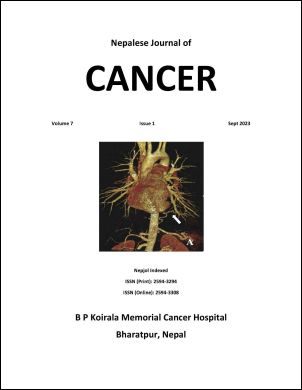Anastomotic leak after esophagectomy
DOI:
https://doi.org/10.3126/njc.v7i1.59993Keywords:
esophageal cancers, esophagectomy, anastomotic leakAbstract
Background: Esophageal anastomotic leakage (AL) remains a frequent and feared postoperative complication, associated with high mortality and impaired quality of life. The aim of this study was to assess AL rates after esophagectomy with anastomosis at neck for esophageal and gastroesophageal junction cancer (GEJ), and compare the impact of AL on oncological outcome.
Methods: Patients with squamous cell carcinoma and adenocarcinoma of esophagus/ gastroesophageal junction who underwent surgery between 2001-2018 were analyzed for cervical anastomotic leak.
Results: 419 patients underwent esophagectomy with anastomosis placed at neck during 2001-2018. AL rate was 16%. AL was not found to be associated with anastomotic technique, surgical approach and technique, organ of conduit and route of conduit. A subgroup of patients (n=93) who had undergone neoadjuvant chemoradiation followed by surgery had AL of 30% vs 12% in rest of the treatment modality group (p<0.001). Median survival was 26 months and 34 months in patients with AL and without AL, respectively (p=0.03). AL was managed successfully in all patients.
Conclusion: Cervical AL after esophagectomy for cancer of esophagus and GEJ can be treated successfully without major complications.
Downloads
Downloads
Published
How to Cite
Issue
Section
License
Copyright (c) 2023 Nepalese Journal of Cancer

This work is licensed under a Creative Commons Attribution 4.0 International License.
This license lets others distribute, remix, tweak, and build upon your work, even commercially, as long as NJC and the authors are acknowledged.
Submission of the manuscript means that the authors agree to assign exclusive copyright to NJC. The aim of NJC is to increase the visibility and ease of use of open access scientific and scholarly articles thereby promoting their increased usage and impact.




